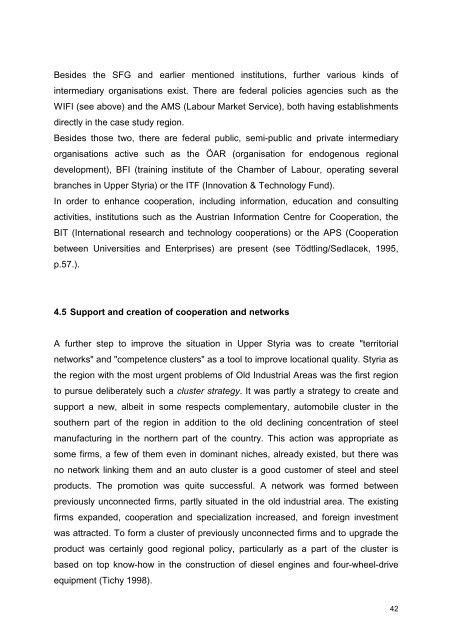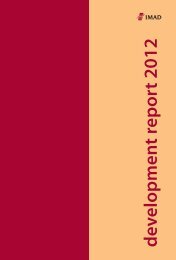Institutional Change in Old Industrial Areas – Lessons for ... - UMAR
Institutional Change in Old Industrial Areas – Lessons for ... - UMAR
Institutional Change in Old Industrial Areas – Lessons for ... - UMAR
Create successful ePaper yourself
Turn your PDF publications into a flip-book with our unique Google optimized e-Paper software.
Besides the SFG and earlier mentioned <strong>in</strong>stitutions, further various k<strong>in</strong>ds of<br />
<strong>in</strong>termediary organisations exist. There are federal policies agencies such as the<br />
WIFI (see above) and the AMS (Labour Market Service), both hav<strong>in</strong>g establishments<br />
directly <strong>in</strong> the case study region.<br />
Besides those two, there are federal public, semi-public and private <strong>in</strong>termediary<br />
organisations active such as the ÖAR (organisation <strong>for</strong> endogenous regional<br />
development), BFI (tra<strong>in</strong><strong>in</strong>g <strong>in</strong>stitute of the Chamber of Labour, operat<strong>in</strong>g several<br />
branches <strong>in</strong> Upper Styria) or the ITF (Innovation & Technology Fund).<br />
In order to enhance cooperation, <strong>in</strong>clud<strong>in</strong>g <strong>in</strong><strong>for</strong>mation, education and consult<strong>in</strong>g<br />
activities, <strong>in</strong>stitutions such as the Austrian In<strong>for</strong>mation Centre <strong>for</strong> Cooperation, the<br />
BIT (International research and technology cooperations) or the APS (Cooperation<br />
between Universities and Enterprises) are present (see Tödtl<strong>in</strong>g/Sedlacek, 1995,<br />
p.57.).<br />
4.5 Support and creation of cooperation and networks<br />
A further step to improve the situation <strong>in</strong> Upper Styria was to create "territorial<br />
networks" and "competence clusters" as a tool to improve locational quality. Styria as<br />
the region with the most urgent problems of <strong>Old</strong> <strong>Industrial</strong> <strong>Areas</strong> was the first region<br />
to pursue deliberately such a cluster strategy. It was partly a strategy to create and<br />
support a new, albeit <strong>in</strong> some respects complementary, automobile cluster <strong>in</strong> the<br />
southern part of the region <strong>in</strong> addition to the old decl<strong>in</strong><strong>in</strong>g concentration of steel<br />
manufactur<strong>in</strong>g <strong>in</strong> the northern part of the country. This action was appropriate as<br />
some firms, a few of them even <strong>in</strong> dom<strong>in</strong>ant niches, already existed, but there was<br />
no network l<strong>in</strong>k<strong>in</strong>g them and an auto cluster is a good customer of steel and steel<br />
products. The promotion was quite successful. A network was <strong>for</strong>med between<br />
previously unconnected firms, partly situated <strong>in</strong> the old <strong>in</strong>dustrial area. The exist<strong>in</strong>g<br />
firms expanded, cooperation and specialization <strong>in</strong>creased, and <strong>for</strong>eign <strong>in</strong>vestment<br />
was attracted. To <strong>for</strong>m a cluster of previously unconnected firms and to upgrade the<br />
product was certa<strong>in</strong>ly good regional policy, particularly as a part of the cluster is<br />
based on top know-how <strong>in</strong> the construction of diesel eng<strong>in</strong>es and four-wheel-drive<br />
equipment (Tichy 1998).<br />
42
















